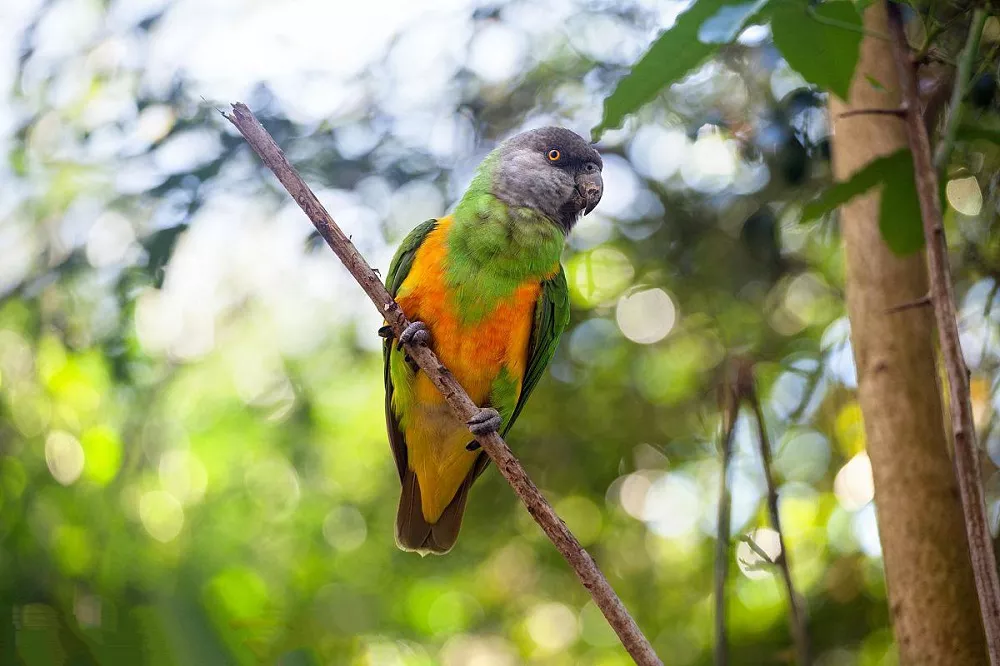The Senegal Parrot (Poicephalus senegalus) is a small and captivating parrot species native to the woodlands and savannahs of West Africa. Renowned for its vibrant plumage, playful personality, and remarkable intelligence, the Senegal Parrot has become a popular choice among bird enthusiasts and pet owners. In this article, we will explore the key characteristics, behavior, care requirements, and conservation status of the Senegal Parrot.
Physical Characteristics:
The Senegal Parrot is a small to medium-sized parrot, typically measuring around 23 centimeters in length. It showcases a predominantly green plumage, with a grayish head and neck, a bright yellow patch on the chest, and a striking V-shaped red or orange belly patch. These distinctive colorations, along with its expressive yellow eyes and horn-colored beak, contribute to the Senegal Parrot’s unique and captivating appearance.
Behavior and Intelligence:
Senegal Parrots are highly social and intelligent birds known for their playful and interactive nature. They possess an impressive ability to mimic sounds, including human speech, making them engaging and entertaining companions. Their intelligence extends beyond mimicry, as they can learn various tricks, solve puzzles, and demonstrate problem-solving skills. This species has a curious and exploratory nature, often engaging in playful behaviors and exhibiting a keen interest in their environment.
Habitat and Natural Distribution:
In the wild, Senegal Parrots are primarily found in West Africa, including countries such as Senegal, Gambia, Guinea-Bissau, and Mali. They inhabit a range of forested areas, woodlands, and savannahs, where they rely on trees for nesting and foraging. These parrots are adaptable and can also be found in agricultural areas and even urban environments.
Diet:
A balanced diet is essential for the health of your Senegal parrot. In the wild, they consume a variety of foods, including fruits, vegetables, seeds, and insects. As pets, it is important to provide them with a similar variety of foods. Pelleted diets formulated specifically for Senegal parrots are available and should make up the bulk of their diet. Fresh fruits and vegetables should also be offered daily, along with small amounts of nuts and seeds.
Care and Husbandry:
As companion pets, Senegal Parrots require dedicated care and attention to ensure their well-being. Adequate housing should include a spacious cage or aviary with plenty of room for exercise and natural behaviors, along with perches of varying sizes to promote foot health. A balanced and nutritious diet consisting of high-quality pellets, fresh fruits, vegetables, and occasional treats like nuts or seeds is crucial for their overall health.
Enrichment and mental stimulation are vital for the Senegal Parrot’s well-being. They thrive on regular social interaction, playtime, and the opportunity to explore their surroundings. Providing a variety of toys, puzzles, and foraging opportunities can keep them engaged and mentally stimulated.
Training:
Senegal parrots are intelligent and can be trained to perform a variety of tricks, including talking. However, training requires patience and consistency. Positive reinforcement techniques, such as offering treats or praise, are effective methods for training your Senegal parrot. It is important to remember that these birds have a strong personality and may require some time to warm up to new people or environments.
Health Concerns:
As with any pet, regular veterinary check-ups are essential for keeping your Senegal parrot healthy. Common health concerns include respiratory infections, feather plucking, and malnutrition. It is important to provide your bird with a clean environment and a balanced diet to prevent these issues from arising.
Conservation Status:
The Senegal Parrot is currently listed as a species of least concern on the International Union for Conservation of Nature (IUCN) Red List. However, habitat loss and fragmentation, as well as illegal trapping for the pet trade, pose significant threats to wild populations. Sustainable management of their native habitats, regulation of the pet trade, and conservation efforts focused on protecting their natural breeding and foraging sites are essential to ensure the long-term survival of the species.
Conclusion:
The Senegal Parrot stands out as a captivating and intelligent companion bird, delighting bird enthusiasts with its colorful plumage, playful behavior, and remarkable mimicry skills. When provided with proper care, social interaction, and mental stimulation, these parrots can form strong bonds with their human caregivers and become cherished members of the family. As we appreciate the beauty and intelligence of the Senegal Parrot, it is crucial to support conservation efforts to protect their wild populations and their natural habitats for future generations to enjoy.


 Facebook
Facebook  Instagram
Instagram  Youtube
Youtube 